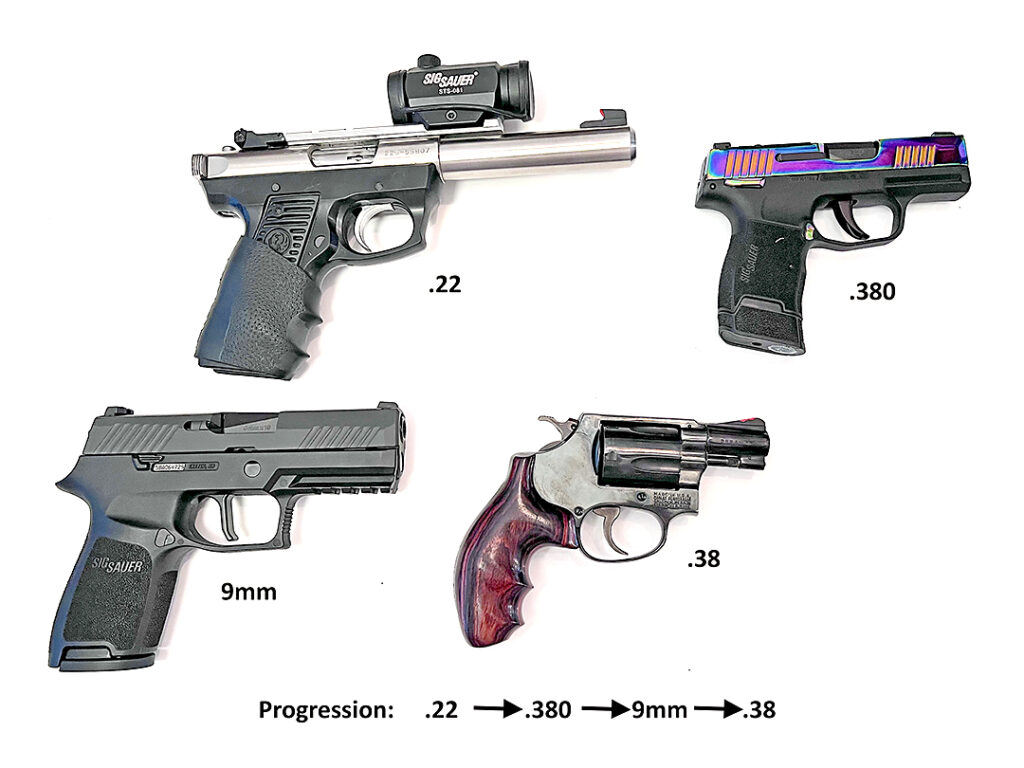Trying out new handguns

By MARJ LAW
“Will you be at the range on Wednesday?” asks Nicky who has contacted me in an email to ask for some assistance.
“Sure!” I write back. “By the way, do you have a handgun? Or are you looking to purchase one?”
“Oh, I do have my own gun,” she replied. “I have a revolver.”
“Good,” I’m thinking. Hopefully, she’ll have a .22 with a nice long barrel. This is a great way to begin shooting. Then, after learning about safety at the range, stance and grip, she can build up confidence to graduate to a .380 like Maggie did last week.
So, the following Wednesday, Nicky turns out to be a slender and fine-boned woman waiting for me at the pistol range.
“Are you Marj?” she asks. “I’m Nicky. And here is my husband, Henry.”
Come to find out, Henry works for one of the law enforcement agencies. I’m wondering why Nicky would like assistance, since her husband may have more experience than I do.
“I’ve read your column, and would like you to work with me on my gun,” Nicky explains. Her husband steps back, giving me time alone with her.
The range is “hot” so we are allowed to handle our guns. Fortunately, Nicky has brought hers in a gun sack, knowing not to bring a “naked” firearm to the range. She places the case on the shooting bench and brings it out. My heart sinks.
Her handgun is a .38.
Drat. I am troubled when new shooters have .38 revolvers. Husbands often purchase .38s for their wives because revolvers will “never jam” and are “simple to operate.”
And that’s sort of true. Revolvers are much simpler to operate than semi-automatic handguns. Basically, you point and shoot. So long as you keep it clean and lubricated and use good quality ammunition, the gun shouldn’t jam.
Unfortunately many new shooters, especially those who are mature (getting along in years), and/or have a small bone structure or hand limitations, find they have trouble handling the strong recoil of the .38. The ultra-light .38, which some women think they want for their purses, has an especially hard recoil. I don’t even like it myself.
In fact, the first question I get from almost every new shooter is: “How bad is the kick?” They do not want to handle much recoil.
Henry notices the disappointed look on my face.
“Nicky has to be safe at her job. If someone were to force his way into her office, she will have a gun ready to point and shoot,” he clarifies the intended use of her gun.
The right gun for any person is the gun that fits the need for them, and has to be a gun they can handle. Although I personally don’t care for the .38 and would not suggest it as a target or a “learner” handgun, in this case the .38 is a good choice for Nicky.
“I can shoot it a few times, but it hurts my hands to shoot longer,” Nicky says.
Since I’m not sure of her prior experience, we discuss safety rules. We talk about a “hot” and “cold” range, and make sure she has safety glasses and ear muffs for vision and hearing protection. We discuss getting a firm grip, and I see she already has a strong stance. She loads the gun and is aiming carefully. She keeps her finger properly off the trigger. Looks like Nicky has had experience before.
She shoots. Blam! Blam!
All six shots hit the 8-inch “Shoot-n-See” target.
“Great job!” I say happily. “You got Mr. Bad, and he is down, down, down!”
Nicky is shaking her hand. “Yes, but now my hand hurts.”
“Since you’re not having difficulty shooting this gun, and it will work for your specific needs, would you like to shoot a different gun with less recoil?” I wonder.
Nicky’s game.
“Can she shoot your 9mm Glock?” I ask Henry. He’s willing, so he shows Nicky how to load the magazine. He puts in five rounds and jabs the magazine into the grip. He hands Nicky the gun.

Blam! Blam!
Nicky hits the target with all five shots. Pretty good!
Normally, I’d have started a new shooter with a .22, then moved up to .380, then a 9mm and finally a .38. However, now since she has shown she is competent with both the .38 and the 9mm, I’d like her to try the .380.
“This small .380 has a short barrel and there’s not a lot of mass. Mass helps to absorb recoil. Less recoil usually makes it easier to hit the target because the shooter isn’t flinching in anticipation of a hard kick.”
Since Nicky has already watched Henry load the semi-automatic 9mm, I ask her to go ahead and load five rounds in the Sig. She loads carefully, then pushes the magazine into the gun. She jacks the slide. I notice that she might not have pulled back the slide all the way, but I’ll wait to see.
When she pulls the trigger, nothing happens. Because she hasn’t pulled the slide back all the way, the round has not loaded into the chamber.
“So, what do you do now?” I ask.
Nicky thinks for a moment. Then she pushes the magazine release button. She pulls the slide back to inspect that the ejection port and chamber are empty. I’m pleased that she appears totally unruffled. Most newer shooters are unnerved when something doesn’t happen as expected, but Nicky takes it in stride.
“Let’s load it again, but this time, jack the slide all the way back and then be sure to let go like a slingshot. Do not ride the slide forward,” I advise.
She jacks the slide and aims. She pulls the trigger.
Blam! Blam!
Wow! These holes in the target are even closer to the x-ring.
“That was so much easier!” she exclaims, and finishes emptying the magazine.
“I really like this one!” she says happily. “I like the grip, and it fits nicely in my hand.”
“This little Sig is small, and it is also fairly expensive,” I warn Nicky and Henry. “There’s a .380 Glock about this size too. Both are both striker-fired handguns. The Sig holds more rounds but is more expensive than the Glock.”
Henry grins.
“It’s only money,” he says. “I knew she’d like it.”
Marj Law is the former director of Keep Wakulla County Beautiful who has become an avid shooter in retirement.


